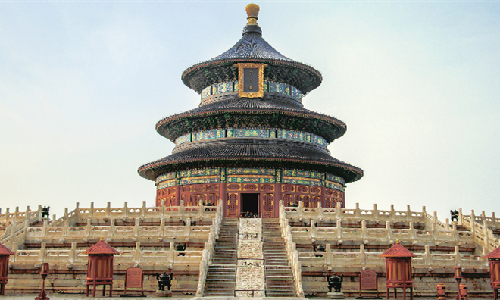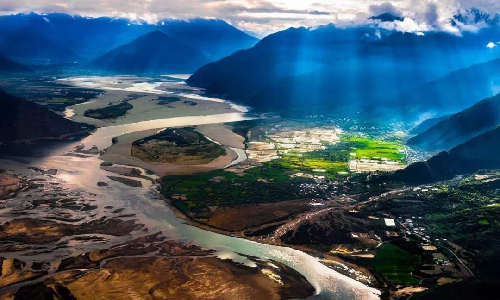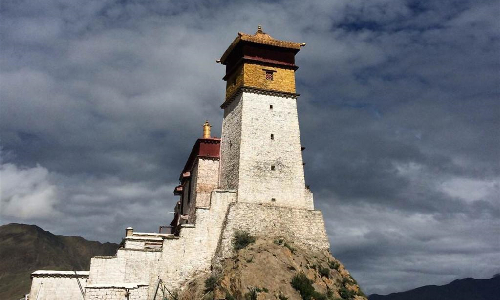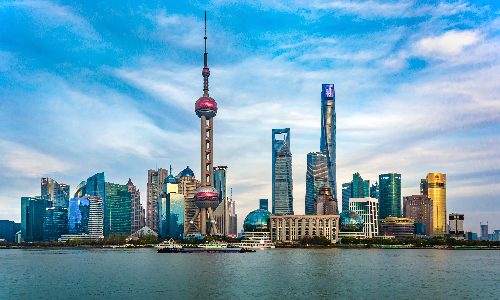China has been a mysterious place to many western countries, and Tibet is the most mysterious place in China. Tibet is famous for its beautiful scenery, long history, unique customs and folklore. Have you ever put Tibet on your travel alternative list too? What's holding you back? Is it the complicated procedure of permits of Tibet? Or is it lack of a perfect plan? Now is the time to make the decision! China Tour Star will be your professional consultant, and we will take good care of all your needs. If you would like to travel to Tibet, this itinerary will be your best choice. A Tibet tour must start from another city in China for transportation. Beijing and Shanghai are the must-see cities in China, and these two cities are also the most accessible ones in China. And a Xi’an tour is also one of the best of China tours. Enter from Beijing, and then travel to Xi’an and Lhasa, and depart from Shanghai. This is the best China tour package. You will have an in-depth understanding of China after this trip. Have a real trip is better than reading the ten best China guide books!

Upon your arrival, your guide will be waiting for you at the arrival hall of Beijing airport. Then you will be transferred to the hotel. During the driving to the hotel, you can ask the guide any questions about Beijing. Your guide will be helpful all the time. After your check-in, if you want to go around, the guide will give you some advice.
Your Beijing tour will starts from Tian’anmen Square. Tian'anmen Gate was the main gate of the Imperial Palace (the Forbidden City) in Beijing during the Ming and Qing Dynasties. And only the emperors were allowed to enter through it in the past. During the Ming and Qing Dynasties, Tian'anmen Square was an imperial square outside the main gate of the Forbidden City in Beijing. It was surrounded by walls on the east, west, and south to form a forbidden area that was not accessible to normal people. It was not until 1925 that Tian'anmen Square was opened to the public. As the biggest city center square in the world, it has become the symbol of New China, too. After the founding of New China, the Great Hall of the People, the Memorial Hall of Chairman Mao, the National Museum, and the Monument to the People's Heroes were built one after another around Tian’anmen Square.
Walking from Tian’anmen Square to the Forbidden City, it is like a time travel. The Forbidden City (closed each Monday) is not only the residence of the emperors, but also a large museum. Once the Forbidden City was secretive, remote, and with a touch of majesty. But after years of development, it has become an accessible museum. The Chinese have always had a yearning for the Forbidden City, as hundreds of years of history of feudal China stopped here. As an ancient palace, it is the largest in the world. As a museum, it is the most visited in the world. During your stroll in the Forbidden City, you may see some cute cats on the wall, or in the corners. These cats are not feral, but descendants of the cats kept by imperial families of the Ming and Qing Dynasties. People from other cities often send them cat food. These cats make the large, majestic Forbidden City approachable.
After lunch, you will go to see the pandas at Beijing Zoo. Beijing Zoo is the first zoo in China to open and to keep the largest variety of animals. Here you will see the adorable giant pandas in Panda House. The giant panda was first named the "black and white bear" because nature gave it only black and white fur. After repeated studies by taxonomists, it was named the giant panda in 1871. You may see the giant pandas eating, playing, or sleeping here.
And then you will go to have a visit to the Summer Palace. Each summer, the emperor would take his family to move to the Summer Palace to escape from the heat. There are some must-see attractions in the Summer Palace, and I’d like to introduce Suzhou Street to you. Suzhou Street, also known as "Buy and Sell Street", was built on both sides of Houhu Lake in imitation of the water towns in Southern China. There were various stores on the shore during the Qing Dynasty, such as jade antique stores, silk stores, dim sum stores, teahouses, and gold and jewelry stores. This place was built for imperial families to have fun. Shopkeepers in the stores were pretended by eunuchs and palace maids. Dozens of stores on the shore of the Houhu Lake were burned down in 1860 and rebuilt in 1986.


Today you will visit Sacred Way, Chang Tomb of Ming Tombs, and the Great Wall.
First, you will drive about 1 hour and 45KM to the Sacred Way. The Sacred Way is the leading road to the Chang Tomb. The ancient feudal emperors believed that after death, people still needed everything in the underworld, such as clothing, food, housing, and transportation. Therefore, in the construction of the mausoleum, it was necessary to recreate the scenes of life before death. Therefore, stone figures and stone beasts were erected on both sides of the Sacred Way to show the majesty of the emperor.
After visiting the Sacred Way, you will see the Chang Tomb, one of the Ming Tombs. Chang Tomb is the tomb of Emperor Zhu Di, the third emperor of the Ming Dynasty. Zhu Di was the most accomplished emperor of the Ming Dynasty. During his reign, he ordered the Yongle Dadian to be written. It was an encyclopedia of unprecedented scale in the content. There are 22,937 volumes, including 16 volumes of catalogs, totaling about 370 million words. In addition to this, he sent his troops to the north several times and brought peace for the Ming Dynasty for many years later. The emperors in the Ming Dynasty chose the site for their tombs according to Chinese Fengshui. Chinese believe a tomb site with good Fengshui will bring good fortune for their descendant. Therefore, Emperor Zhu Di built his tomb here to ensure the Ming Dynasty could last longer and be prosperous.
After lunch, you will visit the Great Wall. According to historical documents, more than 20 vassal states and feudal dynasties had built the Great Wall, and if we add up the Great Wall built in various eras, there were more than 50,000KM. Now only about 20,000KM is left. Today we will take you to visit one section of the Great Wall, the Mutianyu Great Wall. There are much fewer tourists than in other sections, especially in the afternoon. Mutianyu Great Wall was built in the Ming Dynasty and is one of the best-preserved sections. There are thousands of crenels on the wall. Standing behind one of them, you could imagine the soldiers fighting with the enemies on the wall. In addition to climbing the Great Wall, there are also other activities for your choice. You could take a helicopter tour to have a bird view of the Great Wall. Seeing the Great Wall from the high, you will find it looks like a giant dragon lying on the mountain.


 Xi’an
Xi’an This morning, you will have a visit to the Temple of Heaven. It was the place for the emperors in the Ming and Qing Dynasties to pray to the god of heaven for a good harvest. Now it becomes a scenic spot as well as a park. Local people do morning exercises here. You may see various Chinese special exercises here, like swordplay and Tai Chi. Tai Chi is one of the Chinese traditional martial arts, namely Kungfu. If you are interested in it, make friends with the locals who are practicing Tai Chi. They may teach you some moves.
Then you will take the estimated high-speed train G88 13:32/17:55 from Beijing to Xi’an.


Today you will drive about 1 hour and 40KM to visit the Terra Cotta Warriors and Horses Museum. The Terra Cotta Warriors and Horses Museum has received more than 80 million visitors from home and abroad. If you put the Terracotta Warriors and the sculptures of ancient Greece and Rome together, you may not see the beauty of the Terra Cotta Warriors in terms of art. So why is it a wonder? The first reason is the size of the warriors and horses. All of them were made based on different real persons and horses. So you will see thousands of warriors with different faces, clothes, and hairstyles. These will make you have a sense of real soldiers standing there. The second reason is its large scale. There are more than 8000 terra cotta warriors and hundreds of chariots and horses that have been excavated. The third reason is all of them are man-made, which reflects the level of technology in the Qin Dynasty. After the Terra Cotta Amy was finished, Emperor Qin Shi Huang killed all the craftsmen. Therefore, many techniques were lost, and till now, there are still lots of things that can’t be explained.
After lunch at a local restaurant, you will drive back downtown and visit the Big Wild Goose Pagoda. As the earliest and largest surviving brick pagoda of the Tang Dynasty, the Big Wild Goose Pagoda is typical physical evidence of the architectural form of Buddhist pagoda. It was built for storing the Buddhist sutras brought by Master Xuanzang from India. In 627, Xuanzang set out alone from Chang'an (ancient Xi’an) and traveled 25,000 KM westward for 19 years to seek the true scriptures in India. After he came back, Emperor Gaozong in the Tang Dynasty ordered the construction of the Big Wild Goose Pagoda to store the scriptures.
Then your guide will take you to visit the ancient City Wall. The ancient City Wall, also known as Ming Dynasty City Wall, is the largest and best-preserved ancient city wall in China. It was built in 1370 and completed in 1378. It was built on the basis of the imperial cities of the Sui and Tang Dynasties. Standing on the wall, you can see the ancient buildings in the city of Xi'an from afar. Covered by the glow of the sunset, the ancient buildings will take you back to the Great Tang Dynasty a thousand years ago.
Night Activity:


After breakfast at the hotel, your guide will take you to visit Shaanxi History Museum. Shaanxi History Museum(closed each Monday), the first large modern national museum in China. It is a comprehensive history museum. Since its opening, various forms of exhibitions have been held here. And these exhibitions unlocked the rich cultural connotations of historical relics to the general public. In the museum, you can see the murals of the Tang Dynasty. The murals include the four mythical creatures of ancient China, ancient ceremonial guards, architecture, hunting, life scene, and the friendly exchanges between the Tang Dynasty and its nearby coutries.
Then you will visit the Beilin Museum, which is also known as the Forest of Stone Steles Museum. The Beilin Museum in Xi'an is the earliest in Shaanxi Province. There are 7 steles rooms, 8 steles galleries, 8 steles pavilions, plus a stone carving art room and 4 artifact displays, with a display area of 4,900 square meters in total.
After lunch, you will visit the Great Mosque. Great Mosque, also known as "Dongda Temple", is one of the four largest mosques in China, the largest mosque in Xi'an. It is the main place where more than 60,000 Muslims in Xi'an spend their religious life, and also a key cultural relics protection unit in Shaanxi Province. The Great Mosque is the only mosque built in Chinese traditional style in the world. At last, you can have some shopping time at Muslim Quarter. Muslim Quarter is a famous food and cultural neighborhood of Xi'an. The North Courtyard Gate, where Muslim Quarter is located, was an official district in the Qing Dynasty. Muslim Quarter, as one of the representatives of Xi'an style, is the collective name of several streets in the Muslim Quarter neighborhood. Here you could have a taste of many local snacks, like Chinese hamburgers, rice skin, and soup with mutton and pancake pieces.


 Lhasa
Lhasa This morning, you will take the estimated flight MU2333 08:20/11:35 from Xi’an to Lhasa. Upon your arrival at the airport, our local guide will meet you at the arrival hall. You will be transferred to the hotel in Lhasa city. Along the way, you will enjoy the amazing views along the Yarlung Tsangpo River. The Yarlung Tsangpo River is the longest highland river in China. Located in the Tibet, it is also one of the highest rivers in the world. It originates from the Jema Yangtse Glacier at the northern foot of the Himalayas. And its upper reaches are called the Maquan River, which crosses southern Tibet from west to east. The beauty of the river can’t be written in few words. In case you will miss the most amazing part, have your camera in your hand all the time. After arrival at the hotel, your local guide will help you with check-in. The rest of the day will be yours to rest and acclimate yourself to the high altitudes.


Today you will visit Potala Palace, Jokhang Temple, and Barkhor Street in Lhasa city. The Potala Palace, located on Mount Maburi in the northwest of Lhasa, is a fortress-like building complex originally built by Songtsen Gampo of the Tubo Dynasty. It is built for the marriage Songtsen Gampo and Princess Wencheng. After reconstruction in the 17th century, it became the winter residence of successive Dalai Lamas and was the ruling center of Tibetan politics and religion. Going inside, you will see the frescoes in the main hall, which are unique scenery in the Potala Palace. On the walls with frescoes, there is the history of Tibetan Buddhism, the life of the Fifth Dalai, and the process of Princess Wencheng entering Tibet.
Then you will visit Jokhang Temple. Jokhang Temple, located in the old city center of Lhasa, is a Tibetan Buddhist monastery and was built by the Tibetan King Songtsen Gampo. With a history of more than 1,300 years, Jokhang Temple has a supreme status in Tibetan Buddhism. After the completion, the Jokhang Temple was repeatedly modified and expanded in the Yuan, Ming, and Qing Dynasties. In front of the temple gate, you can see the marks caused by the devotees' kowtowing. Inside the temple, you may see tens of thousands of ghee long-lasting lamps consecrated by believers.
At last, you will go around Barkhor Street. Barkhor Street, also known as Bajiao Street, is the famous circumambulation and commercial center of Lhasa. The original street is just a single street around the Jokhang Temple, and the Tibetans called it the "holy road". After Jokhang Temple was built, it attracted a large number of pilgrims to worship. Gradually there was a path around the Jokhang Temple stepped by pilgrims, which was the original Barkhor Street. With a history of more than 1300 years, it completely preserves the traditional appearance of the ancient city and the way of living.

 Lhasa
Lhasa Today you will drive about 2 hours and 20 minutes(150KM) to go to Tsetang and visit Yungbulhakang Palace. Yungbulhakang Palace is located in Zhaxi Tsering Mountain, 11 kilometers from Tsetang Town, Shannan City, Tibet. "Yungbu" means "doe", because the shape of Zhaxi Tsering Mountain is like a doe. And "lhakang" means "shrine ". Yungbulhakang Palace is the first palace in Tibetan history. It was converted from a palace to a temple during Songtsen Gampo's reign(629AD-650AD). After Princess Wencheng came to Tibet, she would come to live here with Songtsen Gampo every summer.
Then you will go to Trandruk Monastery. Trandruk Monastery is one of the first Buddhist temples built during the Tubo Period(618AD-842AD). The architectural group of Trandruk Monastery is one of the glorious achievements in the history of Tibetan architecture. It is also a material witness to the development and evolution of Tibetan culture and religion. According to legend, Princess Wencheng, by observing the topography of Tubo, found that the entire Tubo is very much like a lying Rakshasa woman, which will be harmful to the Tubo Dynasty. The way to solve this problem was to build temples in the Rakshasa woman's limbs and heart respectively. Trandruk Monastery was the one on one of her arms.
And then, you will visit Samye Monastery. Samye Monastery was built in the 8th century during the Tubo Period. The temple architecture is laid out according to Buddhist cosmology. The central Buddhist hall has Tibetan, Chinese and Indian styles, so Samye Temple is also known as the Three-style Temple. At last of the day, you will drive back to Lhasa city and overnight.


Today you will first go to visit Drepung Monastery. Drepung Monastery is China's Tibetan Buddhism Gelug monastery. Together with Ganden Monastery and Sera Monastery, it is known as the three major monasteries in Lhasa. “Drepung” means “rice pile” in Tibetan, symbolizing prosperity. The entire monastery is on a grand scale, with a cluster of white buildings lined up on the hillside, resembling a huge rice pile from a distance. That’s how the name “Drepung” came from. Drepung Monastery is surrounded by mountains on three sides. In front of the monastery are the Lhasa River and an open valley.
Then you will visit Sera Monastery. Sera Monastery houses tens of thousands of Vajra statues, most of which are made locally in Tibet. There are also many bronze Buddha statues brought from the other provinces of China or India. Sera Monastery's buildings are dense but not crowded. it houses the Ganjur, the first Tibetan engraved version of the Great Tibetan Sutra. This sutra was given by the Yongle Emperor of the Ming Dynasty and is well preserved to this day. Its existence testifies to the jurisdiction of the central government of the Ming Dynasty over the Tibetan region.
At the last of the day, you will see the Norbulingka. The Norbulingka was built in the 1840s (the seventh Dalai). It is a typical Tibetan-style garden where successive Dalai Lamas spend the summertime. After more than two hundred years of expansion, the garden covers an area of 360,000 square meters now. With more than 100 kinds of plants, it becomes a highland botanical garden. And it also is the largest and most scenic man-made garden with the most relics in Tibet. Every Snowdon Festival (the first to the seventh day of the seventh month of the Tibetan calendar), Norbulingka is one of the venues of the festival activity. During the festival, the locals will set up tents all over Norbulingka and the surrounding woods and sit around, playing chess and cards, and singing and dancing.


 Shanghai
Shanghai Today, your guide will take you to visit an ancient Tibetan village. Before that, there is something you may want to know. Tibetans have their own unique food habits. Ghee tea, tsampa, beef, and mutton are known as the "four treasures" of the Tibetan diet. In addition, the basic features of Tibetan dress are long sleeves, wide waist, long skirt, and long boots. You will see Tibetan-style houses with cow-dung walls in the ancient village. Please note that, don’t touch the religious supplies in their house.
Then you will take the estimated flight MU2336 15:30/21:45 from Lhasa to Shanghai. Upon your arrival, your guide will take you to your hotel and check-in.


After a buffet breakfast, you will have a visit to Yu Garden. Yu Garden (closed each Monday) is located in the city center of Shanghai, adjacent to Shanghai City God Temple and Yuyuan Tourism Mall. It is a classical garden in Southern China. With a history of more than 400 years, Yu Garden was built in Min Dynasty. In the late Qing Dynasty, it was destroyed by the war, and becoming the location of business associations later. Till 1956, Yu Garden was rebuilt.
Then you will have some free time in Shanghai Old Street. Here one could taste the authentic Shanghai dim sum from Green Ripple Restaurant, vegetarian buns from Song Yue Lou, and pigeon egg dumplings from Gui Hua Hall. Besides, there are also Shanghai special handicrafts, silk, and other products for you to choose from. All the buildings here are in an old Shanghai style.
Then you can have a walk on the Bund. The Bund, located on the riverside of Huangpu River, was designated as a British Concession in 1844 (the 24th year of the Qing Dynasty). Here you can have an in-depth visit to one of the old buildings on the Bund. You could see the Shanghai of 100 years ago. Then you will visit Nanjing Road. There are lots of snacks that I want to introduce to you. Pan-fried buns from Jianzi Sheng restaurant, fresh meat mooncakes from Lao Dafang dim sum shop, and traditional Shanghai pastries from Shen Dacheng pastry shop. All the above shops are time-honored brands.
At last, you will go to visit Shanghai Oriental Pearl TV Tower. The Oriental Pearl TV Tower is one of the first batch of AAAAA tourist attractions in China. Inside the tower, there are a revolving restaurant, Shanghai city history development exhibition hall, observation deck, space capsule, etc. From the observation deck at 263 meters, you could see the amazing night view of Shanghai.
Options:


Your guide will pick you up from the hotel and send you to the airport, and then you will fly back to your sweet home.
Editor: Summer Hou
| City | Five Star hotel list | Four Star hotel list |
|---|---|---|
| Beijing | Sunworld Dynasty Hotel Beijing Wangfujing | Sunworld Hotel Wangfujing |
| Xi'an | Tianyu Gloria Grand Hotel Xi'an | Sunworld Dynasty Hotel |
| Lhasa | Shangri-La Hotel, Lhasa | Thangka hotel |
| Shanghai | Ocean Hotel Shanghai | Courtyard by Marriott Shanghai Central |
 |
![]() About your child or infant, please contact us for a discounted price.
About your child or infant, please contact us for a discounted price.



We started with a few days in Beijing & ended in Shanghai, from where we visited the Forbidden City and Great Wall. In between we visited Terra Cotta Warriors Museum, Panda Base, Shanghai Disneyland.

We had a wonderful holiday in China which will remain long in the memory. China is a breathtakingly beautiful country full of splendid temples and palaces, mountains and rivers, peaceful rural scenes and bustling shopping streets.
 QUICK ENQUIRY
QUICK ENQUIRY